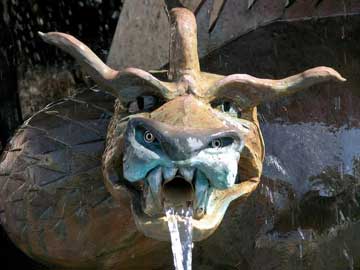 by Preston MacDougall July 07, 2006
This was back in 1998, when my daughter's hair was naturally blonde, and we were spending the summer in a California condominium complex that had a pool. I have to admit that, even without any prodding by Greenpeace, I suspected chlorine was to blame.
Pool water is chlorinated for the purpose of reacting with organic matter, such as bacteria, but hair is organic too. So there was presumably a means. Elements can't have motives, but there was plenty of opportunity - the pool was a novelty for us, and the kids almost developed gills that summer. But, like Lieutenant Columbo, I wasn't ready to jump to the obvious conclusion. I just couldn't fit all the molecular pieces together into a chemical method. Elemental chlorine is a greenish gas. But, most pools are not disinfected with chlorine itself, but a chemical compound that contains chlorine, such as calcium hypochlorite, a type of bleach. This product is sold in little pucks that are as white as table salt (also known as sodium chloride, another compound containing chlorine). Municipal water supplies are also chlorinated - in this case they usually do use elemental chlorine gas - but with no apparent hair tinting. As a chemist, I am accustomed to color changes resulting from making and/or breaking chemical bonds. For instance, organic pigment molecules can lose their color when so-called "unsaturated", or "double bonds" are oxidized. Since bleaches are moderately strong oxidizers, I can understand bleach blondes. But I was struggling with chlorine greens. After questioning a few other blonde victims, my wife and daughter quickly arrived at a chlorine conviction. Fortunately, they just as quickly learned that a certain shampoo company employed a cleverer chemist than the one in our family, and chlorine was given a reprieve. This cosmetic chemist had solved the chlorine green mystery and formulated a shampoo that reversed whatever chemistry had occurred in the pool. My daughter got progressively blonder swimming in sunny California, whereas I felt dumb. Chlorine has not been given such quarter by many environmental activist groups, such as Greenpeace, who are still calling for "a comprehensive phase-out of chlorine and chlorine-based chemicals." Without question, there are environmental problems associated with irresponsible industrial use and disposal of chlorinated compounds, such as PCBs, where C is for chlorinated. On the other hand, there have also been public health tragedies when chlorine was not used, such as the lethal outbreak of E. coli poisoning in the water supply of Walkerton, Ontario, in May 2000. And most importantly, for those who are fortunate enough to have it, drinking water that has been sanitized with chlorine, or chlorinated products, has been the single biggest advance in world health. Still, as when faced with puzzling green hair, I see shades of gray when it seems that many others see things in black and white. The environmental risks and benefits of chlorine chemistry are very complex and far-reaching, with a never-ending supply of news that both concerns and surprises. However, I am still not able to jump to an "obvious" conclusion, as the chlorine-busters have eagerly done. The one thing that is crystal clear to me is that a watertight case can be made for creative, paradigm-busting chemistry research. To give an example, Terry Collins, a chemistry professor at Carnegie-Mellon University, is developing chlorine-free "green oxidation chemistry" that eliminates many of the environmental problems that are associated with traditional methods of "bleaching" wood pulp. Even if this chemistry only finds limited use, at least the students that have had a hand in developing it will have learned the invaluable technical and intellectual skills of actually solving environmental problems. Pointing fingers at people, and drawing slashed circles around chemical symbols, only muddies the water. Oh, one more thing. In 1996, biochemists reported that our own white blood cells have long produced the active ingredient in bleach - the hypochlorite ion - in order to kill natural pathogens. In this case, the smoking gun is an enzyme called myeloperoxidase - a molecular complex that is only a few hundred nanometers in diameter. Even Lt. Columbo would have been impressed by that detective work.
On the Web:
Publish A Letter on SitNews Read Letters/Opinions Submit A Letter to the Editor
|
||
